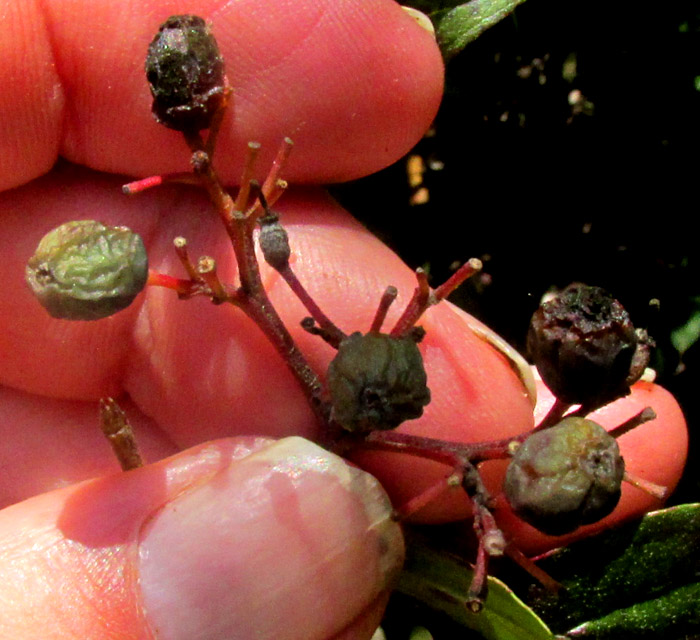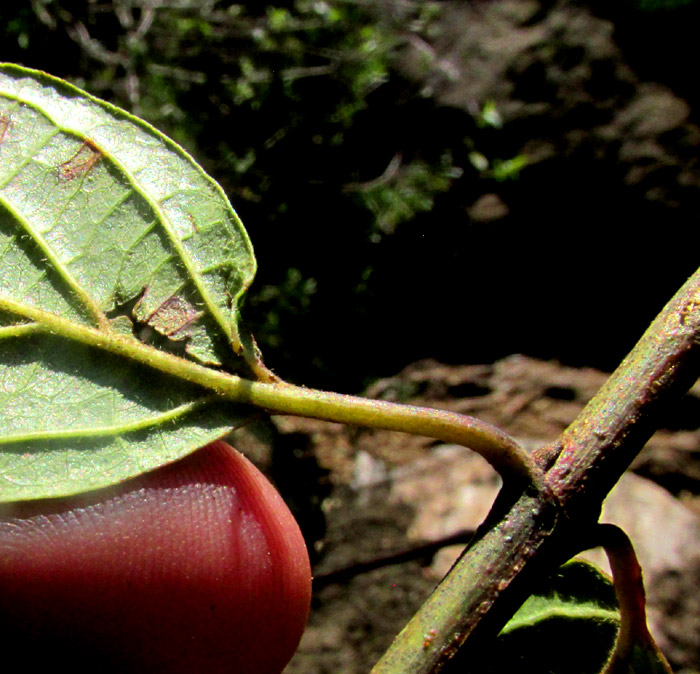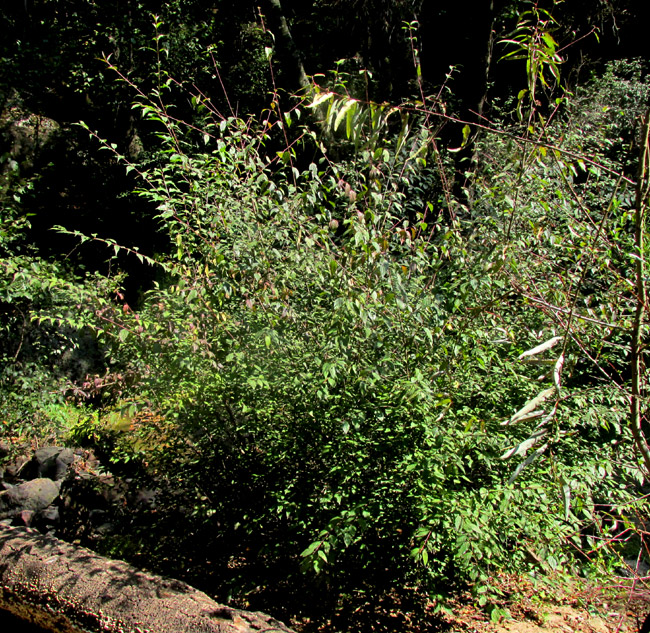Excerpts from Jim Conrad's
Naturalist Newsletter
Entry dated November 9, 2023, from notes taken near Cascadas de La Piedad waterfall 3kms NW of the community of San Pablo, municipality of Almeaco de Bonfil; in canyon of La Piedad below the falls; N20.1017°, W100.0041°, elevation 2360 meters (7750ft); extreme southern Querétaro state, MÉXICO
CORNUS EXCELSA

On the canyon's floor about a halfhearted stone-toss from the stream, the above branch of a dense, much branched, 2.5m-tall bush (8ft) bore several clusters of fruits at several branch tips. With such slender, stiff stems on a small tree or bush with pairs of simple leaves arising opposite one another at stem nodes, and widely spreading, much branched, inflorescences bearing a few drupe-type, pea-sized fruits, the plant's appearance brought to mind species of dogwood, genus Cornus -- such as the Roughleaf Dogwood back in Mississippi. Notice that leaf blades were deeply wrinkled on their surfaces, or rugose.

The few inflorescences bore somewhat fleshy, two-seeded drupes, which were nearly spherical in shape. I read that this species' drupes are white when mature, but above we see wrinkled, dark green fruits turning black, as well as a couple of dried-out ovaries aborted before they could enlarge. Despite our woody plant rooting in gravel about 5m (15ft) from the stream, possibly the fruits' blackness results from the fact that in this area we're experiencing a continuing two-year drought classified by the North American Drought Monitor as a D3 Extreme Drought.

Leaf blades were attached to fairly long petioles, and their undersurfaces were soft-hairy.

Many older leaves were turning dark grape color, the same shade often seen in late summer or early fall on the North's flowering dogwoods. Below, that's what our bushy tree looked like in its entirety:

Dogwoods, genus Cornus, belong to the Dogwood Family, the Cornaceae. Experts agree that some dogwood species can be confused with certain species of Viburnum in the Viburnum Family. However, they point out that flowers of dogwood species usually develop four corolla lobes, while viburnum flowers usually develop four to six. Also the two genera tend to develop different kinds of hairs. When all you have is puckered fruits and old leaves whose hairs mostly have disintegrated, the problem remains. I satisfied myself that this was a dogwood by listing all documented species of Cornus and Viburnum occurring in our highland central Mexican region, and comparing pictures of the species in both families with our plant. There weren't many species to deal with. The viburnum species found here tend to develop weakly toothed leaves while the dogwoods' leaves have no hint of teeth. That suggested that we had a dogwood.
In the 1992 issue of the Flora del Bajío dealing with Dogwood Family species in our region, only one genus was recognized, Cornus, and in that genus only two species were documented for Querétaro state. Among the few differences of the two species to be seen in our pictures, the drupes of one species, Cornus disciflora, are ellipsoidal, while the other's drupes are more or less spherical. Our drupes are almost spherical, so it's CORNUS EXCELSA. Images of leaves of the two species support that choice.
Cornus excelsa bears no commonly used English name, though certain nurseries in England market it as Mexican Dogwood; that name may apply only to horticultural productions, though. Cornus excelsa occurs in mountains throughout most of Mexico, south into Honduras. Its habitats are described as deciduous mountain forests, humid canyons, and sometimes along the sides of usually dry gullies, or arroyos, in oak and pine forests. Our plant couldn't be more at home in this little canyon.
In general it can be said that dogwood species often are used in traditional medicine, because their bark is rich in tannins, which on flesh produce astringent or puckering effects, thus staunching bleeding. Numerous websites report that during the US Civil War dogwood bark infusions in alcohol were used when quinine wasn't available, for the treatment of malaria; no dependable sources of that information is cited.
In the 2004 book Plantas Medicinales del estado de Durango y zonas aledañas, by Martha González Elizonido and others, it's reported that in Mexico's northwestern state of Durango, bark of Cornus excelsa is cooked in water to make a tea for treating stomach ache.
This is yet another species first introduced to science by collections of Humboldt and Bonpland during their visit here in 1803 and 1804. The collections were provided to Carl Sigismund Kunth at Leipzig University, who in 1820 published the discovery under the famous abbreviation of all three men's names, H.B.K., for Humboldt, Bonpland and Kunth. It's like the simple "L" appearing after binomials, designating the master Linnaeus.